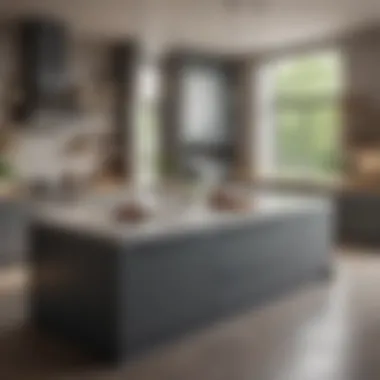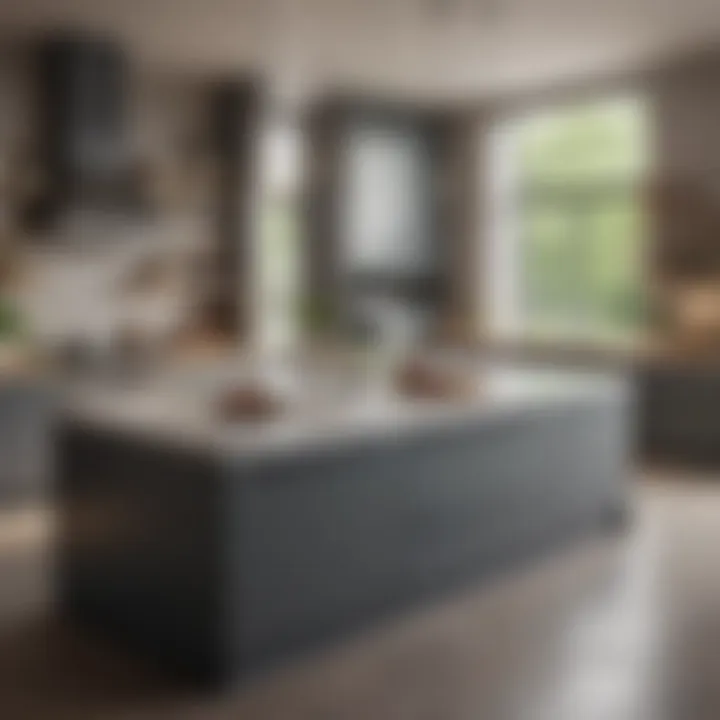Designing the Perfect Kitchen Island with Versatile Features


Intro
Designing a kitchen island requires more than just selecting trendy colors or attractive materials. Integrating functionality with style can significantly enhance the cooking and entertaining experience. A well-planned kitchen island equipped with a sink, stove, and dishwasher serves as a central hub in modern homes, meeting both practical and aesthetic needs. This article explores key design principles and practical considerations vital for creating the ideal kitchen island. We discuss layout, functionality, and aesthetics, focusing on maximizing space efficiency while ensuring a pleasing visual environment. Whether you are a novice designer or an experienced host, this guide aims to elevate your culinary space into a well-organized and inviting area for cooking and gathering.
Interior Design Tips
Trendy Design Ideas
Incorporating a kitchen island with integrated appliances is an opportunity to embrace various design trends. Open-concept layouts are incredibly popular, making islands a focal point rather than an afterthought. Consider a multi-level island where one side has seating and the other features cooking appliances. This arrangement can demarcate the cooking space from the dining area, facilitating social interaction.
Another trend is the use of natural materials. Wood, stone, and metals can introduce warmth and texture. For example, using a butcher block counter paired with sleek stainless steel for the stove creates a delightful contrast.
Color Schemes and Combinations
Choosing the right color scheme is crucial. Neutral tones like whites, grays, or beige are timeless but can be accented with bolder colors. For instance, a navy blue island paired with brass fixtures can offer a sophisticated touch. Mixing materials, like a wooden island with a marble top, not only adds visual interest but can also define different functional areas.
Consider that darker hues can make a room feel smaller. Thus, balance is essential when selecting colors for your kitchen island.
Furniture Arrangement Techniques
The kitchen island should integrate seamlessly with other kitchen elements. Positioning the island at least 42 inches away from surrounding cabinets allows for easy movement. If space permits, include stools or chairs for casual dining, ensuring there’s adequate overhang on the sides.
When it comes to lighting, pendant lights above the island can provide both function and style. Choose fixtures that complement the island's design. These can serve as a decorative element while also illuminating the workspace.
Important Note: The function of the kitchen island should guide design choices. Prioritize practical elements first, then layer on design aspects for beauty.
Entertaining Essentials
Table Setting Inspiration
When hosting, a kitchen island can double as an informal dining space. A well-set table can set the mood for gatherings. Use chic placemats and matching plate sets to create an inviting atmosphere. Fresh flowers or seasonal decorations can also enhance the overall setting.
Menu Planning Tips
A functioning kitchen island allows for meal prep and serving space. When planning a menu, aim for dishes that can be assembled easily. For instance, a taco bar or charcuterie board encourages interaction and makes serving straightforward.
Party Theme Suggestions
The island's design can dictate the theme of a gathering. An island with a prep sink could focus on cooking demonstrations, while one with ample space can facilitate buffet-style dining. Tailoring the island’s function according to your party theme elevates the experience for guests.
Epilogue
Overall, blending practicality with impressive design elements is key to creating a kitchen island that is both functional and aesthetically pleasing. With the right approach, a well-designed kitchen island can become the centerpiece of culinary creativity and social gatherings. This guide captures essential elements to think about while planning your kitchen space, helping you create an environment that inspires both cooking and conversation.
Prologue to Kitchen Islands
The kitchen island is often the focal point of modern culinary designs. Its significance arises from its ability to merge practicality with style, serving multiple functions in one elegant structure. A well-designed kitchen island can enhance the workflow, provide additional storage, and create a comfortable area for socializing or dining. In this section, we explore the definition and importance of kitchen islands as well as the relationship between current trends in kitchen design and the evolving perceptions of these multi-functional spaces.
Definition and Importance
A kitchen island is a standalone unit that typically features a countertop which can be used for food preparation, meal service, and other activities. Including appliances such as sinks, stoves, and dishwashers turns the island into an indispensable part of the kitchen. They are significant not only for their utility but also for their aesthetic appeal.
Homeowners now prioritize open-concept living, and kitchen islands contribute to this desire for connectivity between spaces. They facilitate engagement during meal preparation and create an informal atmosphere that encourages interaction. Additionally, they optimize kitchen space by adding more surfaces for cooking and dining, making them essential in both large and small kitchens. This adaptability increasing their relevance as homeowners seek solutions that elevate both functionality and style.
Modern Trends in Kitchen Design
Modern kitchen design trends reflect a shift towards minimalism, functionality, and sustainability. As homeowners seek to simplify their lives, kitchen islands have evolved into streamlined structures with clean lines and available technology. Some key trends include:
- Multi-Functionality: Many kitchen islands are now designed to house a mix of appliances while providing ample workspace. Integration of technologies, such as smart appliances, is gaining traction.
- Sustainable Materials: The choice of materials for building kitchen islands has shifted toward sustainable options, including recycled countertops and sustainably sourced wood for cabinetry. This is especially appealing to environmentally-conscious homeowners.
- Bold Design Choices: In contrast to the minimalist trend, some homeowners opt for bold colors and unique shapes for their kitchen islands. This serves to create a statement piece within the kitchen, reflecting personal style.
- Open Layouts: Islands are increasingly placed central in open-plan designs, acting as boundaries, yet inviting connection among living spaces.
Overall, kitchen islands are redefining the home environment. From enhancing usability to setting a tone for the aesthetics, their role is prominent in the modern kitchen design landscape.
Planning Your Kitchen Layout
In the realm of kitchen design, planning your layout is not merely a task, but a critical foundation that dictates how the space will function and flow. A well-planned kitchen layout enhances efficiency and usability, making it essential to integrate a kitchen island equipped with a sink, stove, and dishwasher. The layout influences various factors such as workflow, storage, and comfort, ultimately determining the overall enjoyment of the space.
Assessing Available Space
Understanding the available space is the first step in effective kitchen layout planning. Homeowners must evaluate the dimensions of their kitchen, including wall lengths and ceiling heights. Considerations should include the shape of the kitchen—whether it is a galley, L-shaped, or U-shaped design. This informs the size and scale of the island.
When assessing space, take note of the existing pathways to ensure that the design allows for smooth movement. A kitchen island should not become an obstruction. Ideally, there should be at least 42 to 48 inches of clearance around the island to facilitate ease of movement while cooking or entertaining. This clears a way for multiple users to interact in the kitchen without clogging the space.
Work Triangle Concept
The work triangle concept remains a fundamental principle in kitchen layout. It focuses on the relationship and distance between the three key appliances: the sink, the stove, and the refrigerator. The triangle is formed by connecting these three points, with the goal of creating an efficient work area that minimizes unnecessary steps.


The recommended distances between each point of the triangle should ideally range from 4 to 9 feet, ensuring that they are easily accessible to one another but not too far apart. Such proximity contributes to a streamlined workflow, allowing seasoned cooks and novice chefs alike to move fluidly from one task to another.
Incorporating a kitchen island adds functionality without disrupting the triangle. The placement of the sink within the island can optimize work efficiency by reducing the distance to the stove and refrigerator. Additionally, configuring the dishwasher nearby supports an effective clean-up process, all while maintaining a clean flow throughout the kitchen.
"A well-organized kitchen promotes a seamless cooking experience, making the planning stage invaluable."
By carefully considering available space and applying the work triangle concept, homeowners can design a kitchen island that enhances functionality and style. The layout ultimately shapes the cooking experience, influencing the overall satisfaction of how the kitchen serves its purpose in daily life.
Choosing the Right Features
When designing a kitchen island, selecting the right features is crucial. A well-designed kitchen island serves as both a functional space and a visual centerpiece in your kitchen. The ideal combination of features, including the sink, stove, and dishwasher, determines the efficiency and usability of the kitchen. Each component must be selected based on functionality, user preferences, and the overall design of the space.
Sink Selection and Placement
The sink is typically the most integral part of a kitchen island. It becomes the focal point for food preparation and cleaning. Choosing the right sink involves understanding both the size and the style that fits well with the kitchen layout. Consider a deep basin design for large pots and pans or multiple compartments for multitasking.
Placement is equally important. A sink placed in the center of the island promotes access from all sides, enhancing workflow during meal prep. Plumbing considerations also matter. Ensure proper drainage and water lines are easily accessible.
Stove Types and Their Efficiency
The stove forms another key element. Different stove types, such as gas, electric, or induction, offer unique benefits. Gas stoves provide immediate heat control and are loved by many professional chefs. Electric stoves are often easier to clean, while induction stoves heat up rapidly and are energy efficient.
Understanding the family’s cooking habits can steer selection. It’s also wise to evaluate the energy efficiency of the chosen stove. Using energy-efficient appliances reduces bills and environmental impact over time.
Integrating a Dishwasher into the Design
Lastly, a dishwasher enhances functionality remarkably. Its integration within the island saves time and effort for busy hosts. Positioning it close to the sink allows for smooth hand-off when washing dishes. It’s essential to choose a model that complements the overall aesthetics of the kitchen. A built-in dishwasher can provide a seamless look with cabinetry.
All these features together contribute to mastering both functionality and style in your kitchen. Thoughtful selection will ultimately lead to a harmonious layout and an enjoyable cooking experience.
"A kitchen island should not only look good but also serve the needs of those who use it every day."
In summary, when choosing the right features for your kitchen island, consider how each element supports a practical, functional environment while aligning with your personal style.
Material Choices for Functionality and Aesthetics
Selecting the appropriate materials for your kitchen island is not just a matter of aesthetics. It plays a critical role in the overall functionality of the space. The materials you choose will influence everything from durability to maintenance and even how well the island serves your culinary needs. When integrating a sink, stove, and dishwasher, understanding both practical and stylistic elements is essential.
Countertop Materials
Countertops are a focal point in kitchen islands, impacting both appearance and utility. Several material options exist, each with unique properties:
- Granite: This natural stone is quite popular. It is durable and resistant to heat and scratches, making it ideal for high-traffic culinary areas. However, it can be expensive, and sealing is needed to prevent stains.
- Quartz: As an engineered stone, quartz offers a non-porous surface. It comes in various colors and patterns. It is resistant to stains, which simplifies upkeep. The one drawback could be its susceptibility to heat if direct contact should occur.
- Marble: Known for its elegance, marble adds luxury. Unfortunately, it is softer than other materials and can scratch or stain more easily. Regular maintenance is vital to keep it looking good.
- Butcher Block: This material provides warmth and a great working surface for cutting. It requires regular oiling to maintain its integrity. It's less durable than stone options, so care is essential.
- Stainless Steel: If you want a modern look, this material is easy to clean and highly durable. It doesn’t stain, but can show fingerprints. Heat resistance is also excellent, making it suitable for cooking areas.
Each material has benefits and drawbacks. Therefore, exploring your needs and preferences will aid in making the best choice. A beautiful countertop not only enhances the aesthetics but also supports various cooking activities effectively.
Cabinetry and Finishes
The cabinetry and finishes of your kitchen island can elevate its aesthetic while providing necessary storage. Thoughtful selection here complements the chosen countertop materials.
- Wood: Classic and versatile, wood can be finished in various stains or painted. It offers warmth to the space. Different types such as oak, maple, or cherry have unique grains and colors.
- Plywood: This is another option that allows for detailed finishes. It is lighter and potentially cheaper than solid wood options. While strong, it may not withstand wear as well as solid wood.
- MDF (Medium Density Fiberboard): It is smooth and easy to paint. It resists warping but may not endure moisture well unless properly sealed.
- Laminate: Affordable and available in countless designs, laminate can mimic the look of wood or stone. However, it is less durable. It can chip or scratch more easily than other finishes.
Finishes Considerations
Choosing the finish affects not just the visual appeal but also how you feel about maintenance. Glossy finishes are easier to clean but show fingerprints. Matte finishes can hide dirt but might need more effort to keep pristine.
Integrating thoughtful material choices is fundamental in crafting a kitchen island that is both functional and pleasing to the eye.
Ultimately, the right combination of countertop materials and cabinetry finishes will create a harmonious balance between utility and style, allowing you to fully enjoy the heart of your home.
Design Styles for Kitchen Islands
Design styles for kitchen islands play a crucial role in defining the overall character and functionality of a kitchen space. Kitchen islands serve not only as a place for food preparation but also as a central hub for social interactions. The style chosen can enhance the aesthetic quality while ensuring usability. When discussing design styles, it is essential to consider how elements like color, material, and layout come into play. A well-designed kitchen island will reflect personal taste and fit seamlessly into the existing kitchen architecture, thereby elevating the culinary experience.
Contemporary and Minimalist Design
Contemporary and minimalist designs emphasize clean lines and open spaces. These design approaches focus on simplicity and functionality. A contemporary kitchen island might feature sleek countertops made from quartz or granite, paired with cabinetry that has minimal ornamentation. This style is about blending aesthetics with practicality.
Adopting a minimalist approach often means that clutter is reduced. With fewer decorative elements, the kitchen area can appear larger and more organized.
Key considerations for this design include:
- Color Palette: Neutral colors dominate, often using whites, grays, and earth tones.
- Materials Used: Emphasizing durable and modern materials like stainless steel and glass.
- Lighting: Integrated lighting solutions, such as recessed lights or LED strips, can amplify the clean look while providing essential task lighting.
Rustic and Farmhouse Aesthetic


The rustic and farmhouse aesthetic brings a warm and inviting atmosphere to the kitchen. This design type draws on natural materials and vintage elements, often mixing modern functionality with traditional charm. A kitchen island in this style may feature reclaimed wood for the base, complete with a countertop made of butcher block.
The charm of this aesthetic lies in its imperfections. Its natural textures and earthy colors make the kitchen feel lived-in and welcoming.
Consider the following elements when opting for this style:
- Materials and Textures: Natural woods, cotton textiles, and stone are popular choices.
- Decorative Accents: Open shelving or sliding barn doors can serve as functional leads and visual statements.
- Color Choices: Soft, muted colors that reflect nature are common, with whites, greens, and browns dominating the palette.
Traditional versus Modern Elements
The blend of traditional and modern elements allows for a balanced kitchen that pays homage to classic designs while incorporating innovative features. A kitchen island can harmoniously connect old-world charm with contemporary efficiency.
In this style, it’s common to see intricate detailing in cabinetry alongside modern appliances. A classic marble countertop might be paired with state-of-the-art cooking systems to bridge the gap between past and present.
Important factors to analyze include:
- Cabinetry Styles: Raised-panel doors may reflect traditional preferences, while sleek finishes can align with modern ideals.
- Appliances: Integrating advanced technologies like smart ovens or dishwashers can enhance functionality without disrupting historical influences.
- Overall Aesthetic: Strive for a cohesive look that balances ornate details with minimalist features.
"Design is not about what you see but how it makes you feel."
By carefully considering these design styles, homeowners can create kitchen islands that are both functional and visually appealing. The right design choice can transform the culinary space, reflecting personal taste and enhancing the overall user experience.
Practical Considerations
Designing a kitchen island with a sink, stove, and dishwasher goes beyond aesthetics; it is crucial to integrate practical considerations to enhance daily use. When every element works well together, it not only improves functionality but also elevates the overall kitchen experience. Here are some important aspects to take into account:
- Workflow Efficiency: The organization of a kitchen island can greatly affect how smoothly meal preparation occurs. A well-planned workflow minimizes unnecessary movement and time wastage. Ensuring the island is within reach of key appliances and workspaces is essential for optimizing cooking efficiency.
- Accessibility: An essential element is considering who will use the kitchen. Think about the height of countertops and accessibility to sinks and appliances. If children or individuals with mobility issues will use the kitchen frequently, practical design adjustments may be necessary.
Ergonomics and Comfort
Incorporating ergonomics into kitchen design is important for user comfort. Ergonomics focuses on creating a workspace that reduces strain and enhances productivity.
- Counter Height: Standard counter height ranges from 36 to 42 inches. Depending on your height, ensuring the proper counter height helps maintain comfort while cooking.
- Leg Room: When designing a seating area, it is crucial to allow sufficient leg room. A depth of 15 inches from the edge fulfills this need effectively.
- Workflow Arrangement: Consider the layout. Placing the sink, stove, and dishwasher in a logical sequence minimizes back and forth movement. Having frequently used items within reach is also an ergonomic consideration.
Plumbing and Electrical Configurations
Planning for plumbing and electrical configurations is vital in the design phase. Proper installation prevents future complications and ensures functionality.
- Sink Placement: Connecting the kitchen island sink to the plumbing system requires careful planning. The distance from the water source affects installation time and costs.
- Electrical Outlets: It is beneficial to integrate outlets into the island design. This allows for easier access to power for blenders, mixers, or other small appliances.
- Appliance Synergy: Ensuring that all appliances can easily connect to the electrical and plumbing systems in place creates a seamless cooking environment.
Enhancing Usability
In modern kitchen design, enhancing usability is an essential aspect that cannot be overlooked. A kitchen island equipped with a sink, stove, and dishwasher serves as a central hub for cooking and socializing. To maximize its utility, we must consider various factors that contribute to its overall functionality. This involves planning a smart layout, considering workflow, and incorporating practical storage solutions. The objective is to provide a user-friendly environment that accommodates both cooking tasks and gatherings.
Creating an Efficient Workflow
A well-designed kitchen island optimizes the workflow within the kitchen. The concept of the work triangle, which is the distance between the sink, stove, and refrigerator, plays a significant role here. The goal is to minimize movement without compromising on comfort. An efficient workflow ensures that everything needed for cooking is within easy reach, making food preparation seamless.
Consider the positioning of the sink, stove, and dishwasher. Place the sink at the center of the island to facilitate easy access from both cooking and cleaning areas. The stove should be close enough to the sink to ensure transferring ingredients or washed items is quick and simple. Similarly, locating the dishwasher near the sink promotes a streamlined process for loading and unloading dishes.
Research shows that an ideal work triangle should not exceed 26 feet. Keeping this in mind can greatly enhance efficiency in the kitchen.
Another component of creating an efficient workflow involves incorporating adequate electrical outlets in strategic locations. Ensure that there is electrical access for essential appliances, such as mixers and blenders, so they can be used without causing clutter or cord tangling.
Incorporating Storage Solutions
Effective storage solutions are critical for maintaining an organized kitchen island. Functionality is enhanced when there is sufficient storage to accommodate kitchen tools, cookware, and ingredients, preventing overcrowding on the surface. Drawers, cabinets, and shelves can help achieve a balance between accessibility and aesthetics.
Here are some storage ideas to consider:
- Deep drawers: Choosing drawers for pots and pans can create easy access and save space.
- Open shelving: This can display commonly used items, such as cookbooks or decorative dishes, while keeping them within reach.
- Pull-out racks: Incorporating pull-out racks for spices or kitchen gadgets helps keep everything organized without cluttering the countertop.
- Slide-out bins: These can be beneficial for storing trash or recycling, helping maintain cleanliness.
In summary, usability in kitchen island design hinges on a well-planned layout and effective storage solutions. Homeowners and hosts alike will appreciate the practicality these enhancements provide, as they lead to a more enjoyable cooking experience and improved efficiency in the culinary space.
Lighting and Ambiance
Lighting in a kitchen is vital for both functionality and style. When designing the ideal kitchen island with a sink, stove, and dishwasher, the right lighting can enhance everyday tasks and create a welcoming atmosphere for culinary activities and gatherings. Effective lighting emphasizes the features of the kitchen and contributes significantly to the overall aesthetic appeal. A well-lit kitchen island can transform the way a space feels and operates.
Task Lighting Versus Ambient Lighting
Task lighting is designed specifically for activities. In the context of a kitchen island, this includes focused lighting over areas where food preparation occurs. Under-cabinet lights, pendant lights, or recessed lights can serve this purpose effectively by illuminating the space without shadows. Such lighting helps in performing intricate tasks like chopping vegetables or reading recipes.
On the other hand, ambient lighting provides general illumination. This type of lighting sets the tone of the kitchen, contributing to its ambiance. Soft, diffused light creates a relaxing environment, while brighter settings can energize the space. It is essential to find a balance between both task and ambient lighting.
Choosing Fixtures and Placement


The selection of fixtures can significantly impact the kitchen's functionality and design. For instance, pendant lights can add a decorative touch while providing focused light directly onto the island surface. When choosing these fixtures, consider their height and placement; they should hang low enough to provide sufficient task lighting without obstructing views.
In contrast, recessed lights can be placed strategically in the ceiling to offer broad illumination. Layering these lighting options can enhance the visual depth of the space.
Some factors to consider include:
- Style alignment: Ensure lighting fixtures complement the overall kitchen design style.
- Size determination: Choose fixtures in proportion to the island's dimensions.
- Dimming capabilities: Incorporating dimmer switches can adjust lighting levels according to the time of day or need for ambiance.
Creating a perfect setting in the kitchen island area involves careful thought about lighting, ensuring that it maintains both aesthetic appeal and functional effectiveness.
"Proper lighting transforms not just the room but also the experience of cooking and dining."
By integrating thoughtful lighting choices and strategic placement, you can ensure your kitchen island becomes a focal point that reflects style while enhancing usability.
Innovative Technologies
In today’s kitchen design, integrating innovative technologies has become a critical aspect of functionality and style, particularly when designing a kitchen island equipped with a sink, stove, and dishwasher. Smart appliances and energy-efficient systems contribute not just to the culinary experience but also promote sustainability and convenience in residential settings.
Technological advancements have transformed how homeowners interact with kitchen elements. Appliances that can be controlled via smartphones or voice commands allow for seamless cooking and cleaning processes. By embracing these innovations, homeowners can enhance their overall kitchen experience, making daily tasks more manageable while also ensuring that they are up-to-date with modern design trends.
Smart Appliances
Smart appliances are rapidly gaining acceptance in modern kitchens. When considering a kitchen island with a sink, stove, and dishwasher, integrating smart technology presents numerous advantages. Features like Wi-Fi connectivity enable homeowners to monitor and control appliances remotely. For instance, a smart dishwasher can be set to run during off-peak electricity hours, saving money on utility bills.
Moreover, smart stoves equipped with touch screens and recipe suggestions guide users through complex cooking techniques, making meal preparation easier for even the novice cook. These appliances can also send notifications to smartphones when cooking is complete, reducing the chances of overcooking meals.
Some notable examples of smart appliances include:
- Smart ovens by Samsung and Bosch that offer remote access and cooking timers.
- Smart refrigerators by LG that include touchscreens to create grocery lists.
- Smart dishwashers from Miele that adjust cycles based on load size and dirt level.
These appliances not only enhance functionality but also appeal to the increasingly tech-savvy homeowner.
Energy Efficiency Considerations
Energy efficiency is not merely a trend; it reflects a growing awareness of sustainability in kitchen designs. When integrating innovative technologies, consideration of energy efficiency plays a crucial role in long-term utility cost savings and environmental impact.
The usage of energy-efficient appliances can greatly reduce a household's carbon footprint. Dishwashers with energy-saving features consume less water and power compared to older models. Similarly, induction stoves are more energy-efficient than traditional gas burners, heating up quicker and consuming less energy overall.
Homeowners should look for appliances that have energy ratings from organizations such as ENERGY STAR. Choosing appliances that comply with these standards not only save money on energy bills but often come with incentives or rebates from local governments. The best practices in energy efficiency may include:
- Choosing appliances with high energy efficiency ratings.
- Contemplating on using LED lighting in kitchen islands to reduce energy consumption.
- Utilizing smart technology to schedule usage during off-peak hours.
By selecting advanced, energy-efficient appliances, you contribute positively to the environment while enjoying modern conveniences in your kitchen.
Cost Implications and Budgeting
Cost implications and budgeting are crucial when designing a kitchen island with a sink, stove, and dishwasher. This section will break down various costs involved, providing essential insights for homeowners and design enthusiasts.
Initial Costs Versus Long-Term Value
When assessing the cost of a kitchen island, initial expenses must be balanced against long-term value. The upfront costs may include materials, labor, and appliances. Depending on the quality of materials selected, these costs can vary widely. For example, granite countertops may be more expensive than laminate.
It is important to consider how these choices affect future value. High-quality materials tend to last longer, reducing the need for future replacements or repairs. Energy-efficient appliances may have higher initial costs but lead to savings on energy bills over time. Thus, while the initial investment may appear daunting, it can pay off significantly in the long run, both in terms of utility savings and resale value.
Navigating Installation Costs
Installation costs can also present a considerable aspect of the budgeting process. These costs can vary based on several factors. Complexity of the design, the materials chosen, and the specific demands of plumbing and electrical work all affect total expenses. Hiring skilled professionals may be necessary for ensuring compliance with building codes and achieving a flawless finish, especially when integrating multipurpose features in the kitchen island.
It is vital to request multiple quotes from contractors or installers to understand the average costs for your project. This not only equips homeowners with realistic budgeting expectations but also helps in identifying potential red flags. Careful navigation of these costs and planning ahead can streamline the installation process and minimize unexpected expenses later on.
"Budgeting for a kitchen island involves a clear understanding of both initial costs and the potential long-term benefits of the investment."
In summary, the interplay between initial costs and long-term value is essential for creating an ideal kitchen space. A thorough understanding of installation costs can further assist in making informed decisions. This ensures that functionality and style integrate well within budgetary constraints.
Epilogue
The conclusion section serves as a pivotal component of this article, wrapping together the myriad elements discussed regarding the design of a kitchen island with sink, stove, and dishwasher. Each element plays a unique role in creating a harmonious balance between functionality and aesthetic appeal. This is especially true in modern kitchens, where the island becomes a central social and practical feature of the space.
Summary of Key Points
In revisiting some of the essential topics covered, it is vital to emphasize:
- Importance of Layout: Understanding the spatial dynamics of your kitchen can optimize workflow.
- Selection of Appliances: Choosing the right brands and types for your sink, stove, and dishwasher ensures not only functionality but also efficiency.
- Design Styles: Various styles can cater to personal tastes while accommodating practical needs.
- Material Choice: Selecting suitable materials impacts both the durability and aesthetics of the kitchen island.
- Ergonomics and Usability: Attention to ergonomic design enhances everyday comfort and usability.
- Technological Integration: Smart technology can greatly improve kitchen efficiency.
"A well-designed kitchen island not only complements a home's aesthetics but also enhances its utility and efficiency."
Final Thoughts on Kitchen Islands
Ultimately, the kitchen island is much more than just an addition; it is a transformative element that redefines the culinary space. When you thoughtfully integrate aspects such as the sink, stove, and dishwasher into its design, the island becomes the heart of the kitchen. Homeowners and design enthusiasts alike should consider these elements carefully to cultivate an inviting atmosphere conducive to both cooking and socializing.
As you plan or redesign your kitchen, evaluate your lifestyle needs and preferences. Your kitchen island should reflect who you are and how you use your space, making it both a functional component as well as a stylish focal point in your home. Thus, the subsequent journey of maximizing your kitchen can begin with the well-informed choices you make today.







